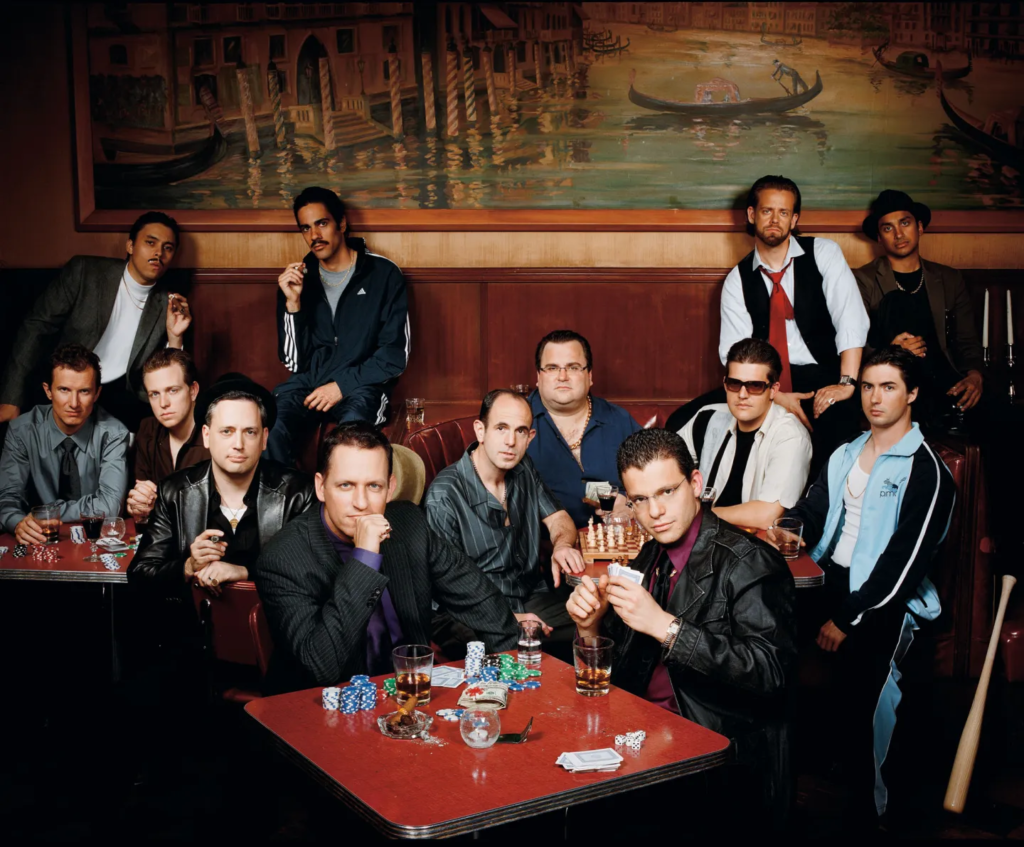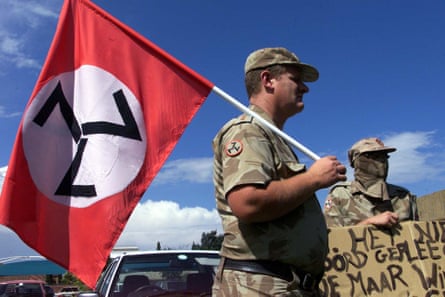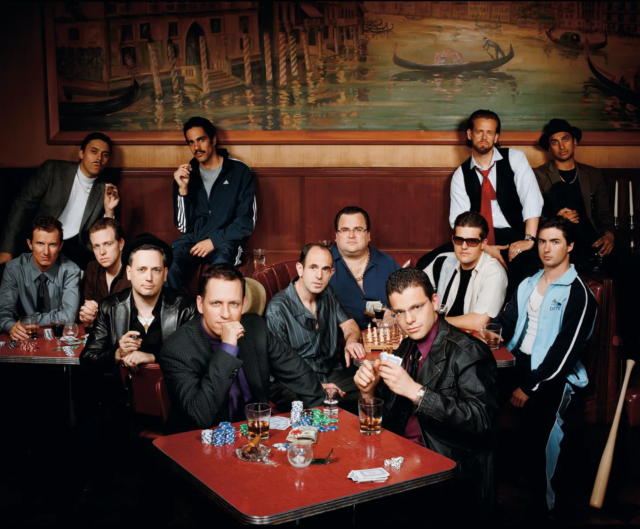
How the roots of the ‘PayPal mafia’ extend to apartheid South Africa
Elon Musk grew up with the privileges of a stratified racial order and Peter Thiel lived in a city that venerated Hitler
When Elon Musk’s arm shot out in a stiff arm salute at Donald Trump’s inaugural celebrations, startled viewers mostly drew the obvious comparison.
But in the fired-up debate about Musk’s intent that followed, as the world’s richest man insisted he wasn’t trying to be a Nazi, speculation inevitably focused on whether his roots in apartheid-era South Africa offered an insight.
In recent months Musk’s promotion of far-right conspiracy theories has grown, from a deepening hostility to democratic institutions to the recent endorsement of Germany’s far-right Alternative für Deutschland (AfD). He has taken an unhealthy interest in genetics while backing claims of a looming “white genocide” in his South African homeland and endorsing posts promoting the racist “great replacement” conspiracy theory. Increasingly, his language and tone have come to echo the old South Africa.
He is not alone. Musk is part of the “PayPal mafia” of libertarian billionaires with roots in South Africa under white rule now hugely influential in the US tech industry and politics.
They include Peter Thiel, the German-born billionaire venture capitalist and PayPal cofounder, who was educated in a southern African city in the 1970s where Hitler was still openly venerated. Thiel, a major donor to Trump’s campaign, has been critical of welfare programs and women being permitted to vote as undermining capitalism. A 2021 biography of Thiel, called The Contrarian, alleged that as a student at Stanford he defended apartheid as “economically sound”.
David Sacks, formerly PayPal’s chief operating officer and now a leading fundraiser for Trump, was born in Cape Town and grew up within the South African diaspora after his family moved to the US when he was young. A fourth member of the mafia, Roelof Botha, the grandson of the apartheid regime’s last foreign minister, Pik Botha, and former PayPal CFO, has kept a lower political profile but remains close to Musk.
Among them, Musk stands out for his ownership of X, which is increasingly a platform for far-right views, and his proximity to Trump, who has nominated Musk to head a “department of government efficiency” to slash and burn its way through the federal bureaucracy.
Some draw a straight line between Musk’s formative years atop a complex system of racial hierarchy as a white male, in a country increasingly at war with itself as the South African government became ever more repressive as resistance to apartheid grew, and the man we see at Trump’s side today.
The week before the inauguration, Steve Bannon, Trump’s former adviser, described white South Africans as the “most racist people on earth”, questioned their involvement in US politics and said Musk was a malign influence who should go back to the country of his birth. Others are sceptical that Musk’s increasingly extreme views can be tracked back to his upbringing in Pretoria. The acclaimed South African writer Jonny Steinberg recently called attempts to explain Musk through his childhood under apartheid “a bad idea” that resulted in “facile” conclusions.
But for those looking to join dots, there is fodder from Musk’s early life with a neo-Nazi grandfather who moved from Canada to South Africa because he liked the idea of apartheid through his high school education in a system infused with the ideology of white supremacy.
Musk’s formative years in the 1980s came amid a cauldron of rebellion in the Black townships which drew a state of emergency and a bloody crackdown by the state. Some whites fled the country. Others marched with the neo-Nazi Afrikaner Resistance Movement against any weakening of apartheid.
The South Africa into which Musk was born in 1971, and to which Thiel moved as a child from Germany, was led by a prime minister, John Vorster, who had been a general in a fascist militia three decades earlier that allied itself with Hitler.
The Ossewabrandwag (OB) was founded shortly before the second world war. It opposed South Africa entering the war as an ally of Britain and plotted with German military intelligence to assassinate the prime minster, Jan Smuts, as a prelude to an armed uprising in support of Hitler.
Vorster made no secret of his sympathy for Nazi, or National Socialist, ideology which he compared to the Afrikaner political philosophy of Christian nationalism.
“We stand for Christian nationalism which is an ally of National Socialism,” he said in 1942. “You can call this anti-democratic principle dictatorship if you wish. In Italy it is called ‘Fascism’, in Germany ‘German National Socialism’ and in South Africa ‘Christian nationalism’.”
Smuts’s government took a dim view of that and a few weeks later interned Vorster as a Nazi sympathiser. At the end of the war, the OB was absorbed into the National party, which then won the 1948 election, in which Black South Africans had no vote, on a commitment to impose apartheid. In 1961, Vorster joined the government as minister of justice and five years later became prime minister.
Nazism may have been defeated in Europe but Christian nationalism was alive and kicking in South Africa under Vorster, with its own brand of racial classification and stratification justified by the need to keep the “swart gevaar”, or black danger, at bay.
In schools, Christian nationalist education sought to forge a South African identity around a singular version of the country’s history. Musk and Thiel were taught that the Afrikaner, mostly the descendants of Dutch colonisers, was the real victim of South Africa’s strife whether at the hands of grasping British imperialists or treacherous Zulu chiefs.
The truth is we didn’t see Black people quite as equals. We didn’t think about it
Phillip Van Niekerk
Bea Roberts, who grew up in an apartheid-supporting family but came to oppose the system and later worked for the Institute for a Democratic South Africa, remembers a heavy emphasis on Afrikaners as victims pursuing apartheid in order to protect their culture and even their very existence.
“It was a strange mix of ‘we got fucked up by the British in the [second Boer] war, and our women and children died in thousands in the concentration camps’ so we are going to rebuild our nation and make sure that that we are invincible. And we’ll do that by extreme means,” she said.
Schooling, like much else, was segregated by race for most of the apartheid era and, on paper at least, white pupils across South Africa were subject to the same Christian nationalist education. But white society was itself divided and the historical narrative embraced in Afrikaans-speaking schools could often became the basis for an implicit rejection of apartheid philosophy in English-speaking ones.
Musk attended a Johannesburg high school and then the Pretoria boys high school, an institution whose other alumni include students who went on to become leading anti-apartheid activists such as Edwin Cameron, a South African supreme court justice after the collapse of white rule, and Peter Hain, who moved to Britain, where he became a leading campaigner against apartheid and then a Labour government minister.
Phillip Van Niekerk, former editor of the leading anti-apartheid Mail and Guardian newspaper in Johannesburg, had Afrikaner parents but attended an English-speaking school. He recalled that the official version of history did little to engender support for the apartheid system among a lot of English speakers even if they benefited from it and did little to challenge it.
“We hated the National party government. Even our teachers were kind of hostile. It was seen almost like an imposition. Yet you imbibe things through the culture. The truth is we didn’t see Black people quite as equals. We didn’t think about it,” he said.
Thiel got all that and more at schools in South Africa and its de facto colony, South West Africa, which became independent as Namibia in 1990.
South West Africa had been a German colony until the end of the first world war and Thiel lived for a time in the city of Swakopmund, where he attended a German-language school while his father worked at a nearby uranium mine.

At that time, Swakopmund was notorious for its continued glorification of Nazism, including celebrating Hitler’s birthday. In 1976, the New York Times reported that some people in the town continued to greet each other with “Heil Hitler” and to give the Nazi salute.









